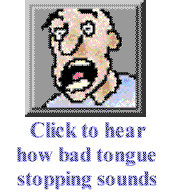


Articulation Part I
 If someone described you as being a
very articulate young person, what would they mean? This would be quite a compliment! It
means that you are very good at expressing your ideas clearly to others.
If someone described you as being a
very articulate young person, what would they mean? This would be quite a compliment! It
means that you are very good at expressing your ideas clearly to others.
Good articulation in flute playing is how we make the ideas the composer put into the music clear. Legato, staccato and slurring are all part of articulation. A question you can never ask yourself too much is, "Can I hear all the different kinds of articulation in the music I am playing clearly and distinctly?" Here's a checklist of articulation problems to listen for:
How to tongue
 Generating vibrato is similar to learning to tongue correctly because some of
the same muscles are involved. Most everyone knows that you say "Too" as you
begin blowing. If that is all you do when you are playing staccato or accenting notes, the
tone will be rather dull and hard sounding. Click the notes to hear an example.
Generating vibrato is similar to learning to tongue correctly because some of
the same muscles are involved. Most everyone knows that you say "Too" as you
begin blowing. If that is all you do when you are playing staccato or accenting notes, the
tone will be rather dull and hard sounding. Click the notes to hear an example.
Try this experiment: Place your hand over your solar plexus (just underneath the bottom
of your ribcage) and cough.
Did you feel the muscle of your upper abdomen contract? Now do the same thing without
engaging your throat in the exercise. It should sound like a forceful "Huh!" if you are doing it
correctly. You should feel those same muscles contract again. Now see if you can do a
number of "Huh's" in a
 row like this: Huh, huh, huh, huh,
huh. Try it slowly at first, then gradually speed it up. This is similar to learning
vibrato but the puff of air is a little sharper with more
separation between each puff. Now add your tongue ("Tuh!") to this puff of air.
You will get articulation that sounds lively, energetic and springy.
row like this: Huh, huh, huh, huh,
huh. Try it slowly at first, then gradually speed it up. This is similar to learning
vibrato but the puff of air is a little sharper with more
separation between each puff. Now add your tongue ("Tuh!") to this puff of air.
You will get articulation that sounds lively, energetic and springy.
To practice this try Trevor Wye's Practice Book 3 - Articulation, staccato etudes especially by Anderson, Reichert Daily Studies #2, exercises in Taffenel-Gaubert Daily Exercises - #4, #10, #12. Make up your own exercises.
Staccato
What is your definition for staccato? Is it "short?" That's what a lot of people think. It's also what a lot of people teach. In some cases it does mean short, but not necessarily. Let's consider this from a different direction. What's your definition for legato? You might say "slurred" or "connected" and you would be correct. Staccato is the opposite of legato, so a good definition for staccato is "separated" or "detached." This makes allowances for the context in which the staccato appears. It isn't "short" if the tempo is relatively slow. That would sound silly and out of place.
Releases
 Just as important as how
you begin a note is how you release it. Do you ever use your tongue to stop the air at the
end of a note? Watch, listen and feel very carefully. My experience shows that many
inexperienced players are not even aware that they are doing this or that it can be a
really big obstacle to becoming a good player. Tongue stopping sounds
a little like the sound an air hose makes when you take it off a tire valve. Not a very
attractive sound when playing a flute.
Just as important as how
you begin a note is how you release it. Do you ever use your tongue to stop the air at the
end of a note? Watch, listen and feel very carefully. My experience shows that many
inexperienced players are not even aware that they are doing this or that it can be a
really big obstacle to becoming a good player. Tongue stopping sounds
a little like the sound an air hose makes when you take it off a tire valve. Not a very
attractive sound when playing a flute.
 The basics of a correct release are
simple: JUST STOP BLOWING. You do not need your tongue to end a note! Practice this until
you make it habit! As this becomes a habit, you can learn to use your lips to create more
of a taper at the end. Also be sure to continue supporting as you blow less. Otherwise the
pitch will go flat. Whatever else you learn about releases, remember, you do not need your
tongue under any circumstances!
The basics of a correct release are
simple: JUST STOP BLOWING. You do not need your tongue to end a note! Practice this until
you make it habit! As this becomes a habit, you can learn to use your lips to create more
of a taper at the end. Also be sure to continue supporting as you blow less. Otherwise the
pitch will go flat. Whatever else you learn about releases, remember, you do not need your
tongue under any circumstances!
Good tone while tonguing
Many students complain that their sound is not as good when they tongue as when they slur. If you think about it, tonguing can be quite explosive. Let's examine what happens when you tongue. Look in a mirror so you can see your lips while you play. Do you notice how the shape of your blowing hole changes when you tongue? For many people, it gets softer around the edges and so they lose the grip on the air stream. This causes the sound to get fuzzier.
A good embouchure grips the air stream firmly rather like how your lips grip a straw to drink. If tonguing disrupts that, it makes sense that an even more firm grip will solve the problem. Be sure to grip with the middle of your embouchure. If you use your smiling muscles in your cheeks at all, you will never learn to do this. Also try tonguing less hard and using more body energy as described above.